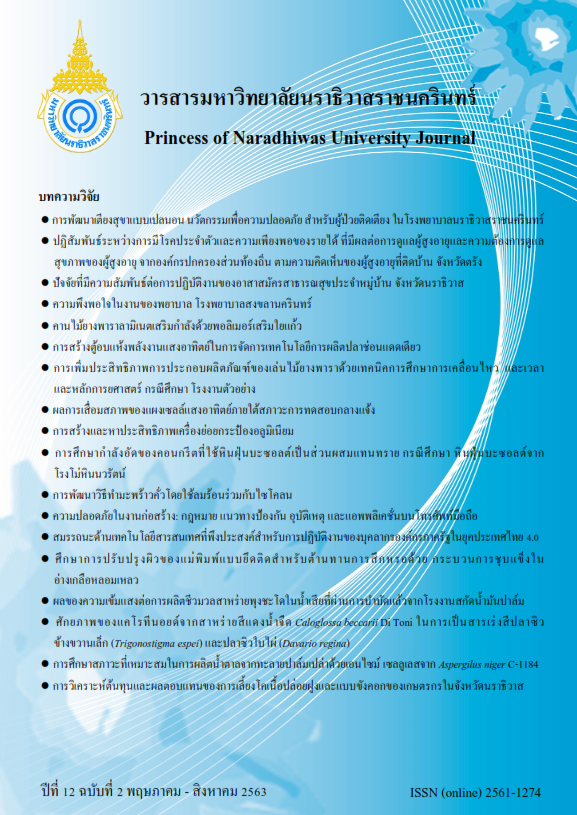ผลของความเข้มแสงต่อการผลิตชีวมวลสาหร่ายพุงชะโดในน้ำเสียที่ผ่านการบำบัดแล้ว จากโรงงานสกัดน้ำมันปาล์ม
คำสำคัญ:
สาหร่ายพุงชะโด, ชีวมวลสาหร่าย, ความเข้มแสง, อัตราการเจริญเติบโตจำเพาะ, น้ำเสียบทคัดย่อ
งานวิจัยนี้เป็นการศึกษาผลของความเข้มแสงต่อการเจริญเติบโตของสาหร่ายพุงชะโด (Ceratophyllum demersum L.) ในน้ำเสียที่ผ่านการบำบัดแล้วจากระบบหมักก๊าซชีวภาพของโรงงานสกัดน้ำมันปาล์ม โดยทำการเปรียบเทียบความเข้มแสงที่ได้รับจากดวงอาทิตย์ในเวลากลางวันร่วมกับการให้แสงเสริมจากหลอดไฟ LED ที่ความเข้มแสง 5,000 และ 10,000 Lux ในเวลากลางคืนต่อการเพาะเลี้ยงสาหร่าย เนื่องจากความเข้มแสงมีอิทธิพลต่ออัตราการดูดซึมของธาตุอาหารจึงมีผลต่อการเจริญเติบโตของสาหร่าย จากผลการทดลองพบว่าเมื่อความเข้มแสงเพิ่มขึ้นส่งผลต่อการทำงานของเซลล์ในการผลิตชีวมวลของสาหร่ายเพิ่มขึ้น โดยชุดการทดลองการเพาะเลี้ยงสาหร่ายพุงชะโดของระบบผสมร่วมระหว่างการให้แสงสว่างจากดวงอาทิตย์ในเวลาระหว่างช่วงกลางวันและให้แสงสว่างเสริมจากหลอดไฟ LED ที่ความเข้มแสง 10,000 Lux ในเวลากลางคืน ทำการเพาะเลี้ยงในน้ำเสียที่ผ่านการบำบัดแล้วจากระบบหมักก๊าซชีวภาพเจือจาง 10 เท่า พบว่าสามารถผลิตชีวมวลสาหร่ายได้ดีที่สุด โดยให้ผลผลิตชีวมวลเป็นสองเท่าของน้ำหนักแรกเริ่มเลี้ยง ใช้เวลาในการเจริญเติบโตเพียง 4 วัน และอัตราการเจริญเติบโตจำเพาะของสาหร่ายพุงชะโดเท่ากับร้อยละ 8.17 ต่อวันของน้ำหนักสาหร่ายแห้ง เมื่อเพาะเลี้ยงสาหร่ายพุงชะโดเป็นระยะเวลา 18 วัน พบว่า สาหร่ายพุงชะโดสามารถบำบัดน้ำเสียได้ดีใน 2 สัปดาห์แรกของการเพาะเลี้ยง และสามารถลดปริมาณไนโตรเจนทั้งหมด และปริมาณฟอสฟอรัสทั้งหมดอย่างต่อเนื่องจนจบการทดลองกับทุกการเจือจางของน้ำเสียที่ผ่านการบำบัดแล้วจากโรงงานสกัดน้ำมันปาล์ม
เอกสารอ้างอิง
Algal Bioresources Research Center, Kasetsart University. (2014). Culture of Caulerpa lentillifera J. Agardh. Retrieved from http://abrc.fish.ku.ac.th/th/. (in Thai).
APHA, AWWA and WEF. (2005). Standard methods for the examination of water and wastewater. 21st Ed, American Public Health Association, New York.
Brennan, L., & Owende, P. (2010). Biofuels from microalgae-a review of technologies for production, processing, and extractions of biofuels and co-products. Renew Sust Energ Rev, 14: 557-577.
Chanchitpricha, C. (1999). The use of microalgae for color and chemical oxygen demand removal in treated molasses. Master Thesis, Science (Environmental Sanitation). Mahidol University. (in Thai).
Cheewasedtham, C., Cheewasedtham, W., & Tjell, J. (2009). Marine algae as biomass for energy production. Proposal submitted to EGAT. Thailand.
Cheirsilp, B., & Torpee, S. (2012). Enhanced growth and lipid production of microalgae under mixotrophic culture condition: Effect of light intensity, glucose concentration and fed – batch cultivation. Bioresource Technology, 110(0), 510-516.
Dilek á, F.B., Taplamacioglu á, H.M., & Tarlan E. 1999. Colour and AOX removal from pulping effluents by algae. Applied Microbiology and Biotechnology. 52, 585-591.
Department of Alternative Energy Development and Energy Conservation. (2010). Production operating guide and safe use of biogas for ranch farms. Bureau of Energy Research, Bangkok. (in Thai).
Division of the Industrial factory. (2010). Operation manual regarding design manufacturing quality control and the use of biogas for Industrial factory. (1st ed.). Bangkok: Ministry of Industry.
(in Thai).
Duangsawast, M., & Somsiri, C. (1985). Properties of water and analysis methods for fisheries research. National inland fisheries institute, (pp.115). Bangkok: Department of Fisheries. (in Thai).
Mata, T.M., Martins, A.A., & Caetano, N.S. (2010). Microalgae for biodiesel production and other applications: a review. Renew Sust Energ Rev, 14: 217-232.
Munoz, R., & Gueiysse, B. (2008). Algae-bacterial processes for the treatment of hazardous contaminants: a review. Water Research, 40(15), 2799-2815.
Park, J.B.K., Craggs, R.J., & Shilton, A.N. (2011). Wastewater treatment high rate algae ponds for biofuel production. Bioresource Technology, 102, 35-42.
Pastare, L., Romagnoli, F., Rugele, K., Dzene, I., & Blumberga, D. (2015). Biochemical methane potential from anaerobic digestion of the macrophyte Ceratophyllum demersum: A batch test study for Latvian conditions. Energy Procedia. 72, 310-316.
Phromaya, C. (2009). Algal – cultivation. Faculty of Fisheries Technology and Water Resources. Maejo University. (in Thai).
Pinkayan, S. (1978). Evaluation of environmental change study of environmental impact at Nam Pong project Northerneast. Thailand. Prepare of National Energy Administration by SEATEC Consulting Engineer. Latvian conditions. Energy Procedia. 72, 310-316.
Qadeer, s., Khalid, A., Mahmood, S., & Anjum, M. (2017). Utilizing oleaginous bacteria and fungi for cleaner energy production. J Clean Prod, 168: 917-928.
Rattanaya, T., Jariyaboon, R., Kongjan, P., Cheewasedtham, C., & Bunyakan, C. (2016). Cultivation of Ceratophyllum demersum L. by wastewater from biogas scrubber. 39th National Graduate Research Conference & 4th International Graduate Research Conference (2016), Assumption University of Thailand, Suvarnabhumi campus, Samuthprakarn, Thailand 30th June-1th July, 2016.
Rodcharoen, S., Sawain, A., & Kraipitthayakorn, W. (2014). Efficiency of cyanobacterium, Phormidium sp. for wastewater treatment of palm oil industry. Rethink: Social Development for Sustainability in ASEAN Community, 11-13 June 2014. (in Thai).
Saeleum, S. (2003). Utilization of wastewater from biogas ponds in pig farm as nutrients for freshwater algae. A thesis of mater degree of Science, Mahidol University.
Travieso, L., Benitez, F., Sanchez, E., Borja, R., Martin, A., & Colmenarejo, M.F. (2006). Batch mixed culture of Chlorella vulgaris using settled and diluted piggery waste. Ecological Engineering, 28(2), 158-165.




